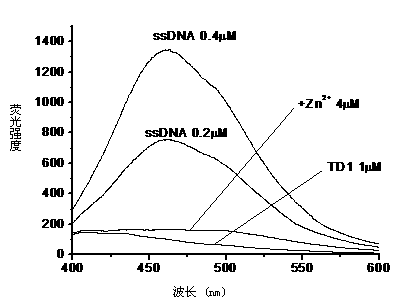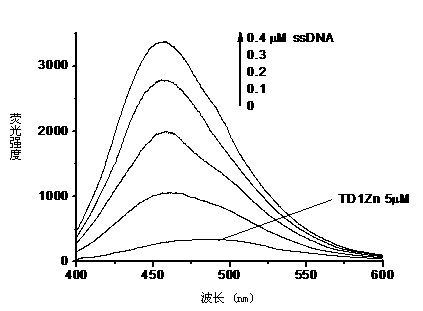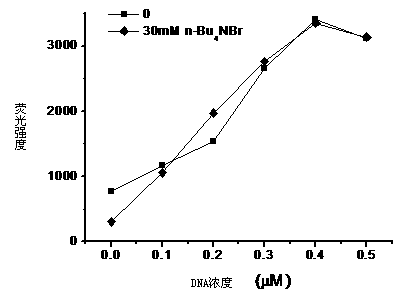Metal complex nucleic acid fluorescent probe
A fluorescence and nucleic acid technology, applied in the field of nucleic acid fluorescent probes, can solve the problems of reducing nucleic acid detection cost, complicated operation, color development of single-stranded nucleic acid, etc., and achieve the effect of inhibiting excitation state relaxation and fluorescence enhancement.
- Summary
- Abstract
- Description
- Claims
- Application Information
AI Technical Summary
Problems solved by technology
Method used
Image
Examples
Embodiment 1
[0050] The synthesis of embodiment 1 ligand TD1 and complex TD1Zn
[0051]
[0052] (1) Synthesis of intermediate b1
[0053] Add 3g of a1 and 0.92g of zinc powder into a 150mL flask, under the protection of argon, add 100mL of anhydrous THF, stir in an ice-water bath, slowly add 0.8mL of titanium tetrachloride, and reflux for 12 hours after the addition is complete. After cooling, add saturated sodium bicarbonate solution to quench the reaction, filter, and concentrate the filtrate under reduced pressure to obtain a crude product. Use chloroform / petroleum ether=1:1 column chromatography to separate the product, and remove the solvent under reduced pressure to obtain 1.56 g of b1 , yield 54%. 1 H NMR (300MHz, CDCl 3 )δ[ppm]: 6.92(d,8H); 6.65(d,8H); 4.23(t,8H); 3.62(t,8H).
[0054] (2) Synthesis of Ligand TD1
[0055] Add 825mg of b1, 2.96g of bis(2-pyridylmethyl)amine (DPA for short), 2.11g of potassium carbonate, and 100ml of acetonitrile into a 150mL flask, reflux for...
Embodiment 2
[0058] Example 2 Ligand TD1 Temporarily Coordinates with Zinc Ions in Solution to Detect DNA
[0059] The ligand TD1 was made into 1 μM acetonitrile solution, the fluorescence was very weak, and 4 μM zinc perchlorate was added to it, the fluorescence enhancement was not significant, and single-stranded DNA was added dropwise, the fluorescence was significantly enhanced. The test results are in figure 1 middle. The fluorescence instrument used was Hitachi F-4500, and the excitation wavelength was 330 nm. The selected single-stranded DNA sequence is: 5'-TTTTTTTTTT-3'.
Embodiment 3
[0060] Example 3 Complex TD1Zn detects DNA in high-concentration electrolyte
[0061] Many single-stranded DNA probes in the literature mainly bind to DNA through electrostatic interactions (see references: Chem. 2008,80,6443–6448), because other negatively charged substances can compete with this type of probe for DNA binding, the detection effect of this type of probe is easily affected by other electrolytes, in order to test whether TD1Zn is also interfered by electrolytes , we did the following test.
[0062] The ligand TD1Zn was made into 5 μM acetonitrile water buffer solution (acetonitrile / water=1:1, v / v; HEPES10mM, pH=7.2), and 30mM tetrabutylammonium bromide was added to the buffer solution in advance, and When single-stranded DNA was added dropwise, the fluorescence was significantly enhanced. Test results such as figure 2 shown. At the same time, when tetrabutylammonium bromide was not added to the buffer solution, the same single-stranded DNA was gradually add...
PUM
 Login to View More
Login to View More Abstract
Description
Claims
Application Information
 Login to View More
Login to View More - R&D
- Intellectual Property
- Life Sciences
- Materials
- Tech Scout
- Unparalleled Data Quality
- Higher Quality Content
- 60% Fewer Hallucinations
Browse by: Latest US Patents, China's latest patents, Technical Efficacy Thesaurus, Application Domain, Technology Topic, Popular Technical Reports.
© 2025 PatSnap. All rights reserved.Legal|Privacy policy|Modern Slavery Act Transparency Statement|Sitemap|About US| Contact US: help@patsnap.com



